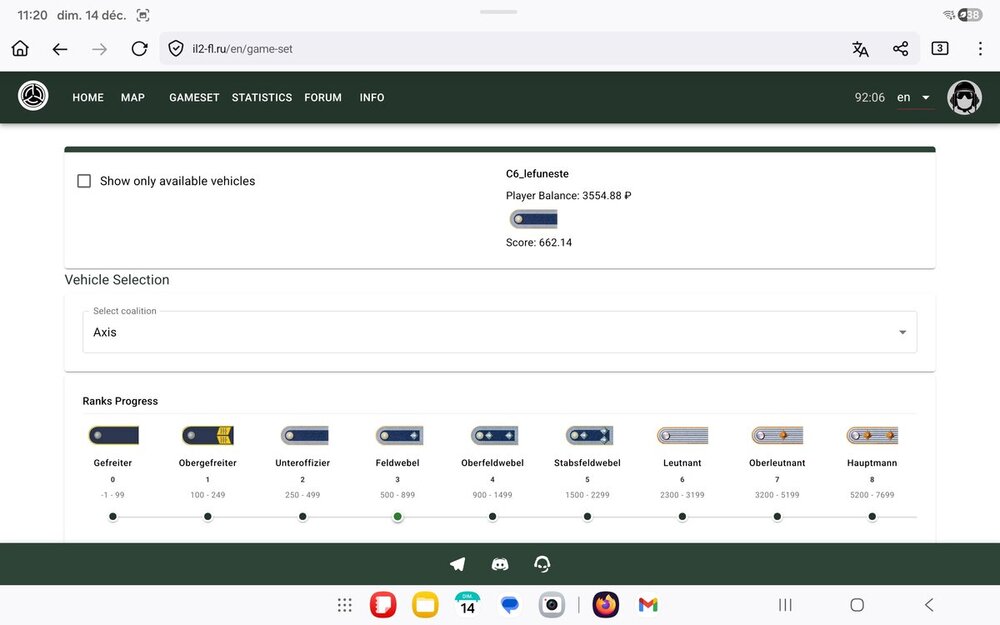All Activity
- Today
-
ChicagoChad_VR started following Information about the server
-
ChicagoChad_VR started following MDA
-
ChicagoChad_VR started following Denisik
- Last week
-
Moscow map 19.12.2025 - airfield supply from ”Outside”The map, is it working the same (as expected) for blue/red sides?
Hello. The losses of the blue side are significantly lower than the losses of the red team. In general, the raid of the red team is higher than that of the blue team. In addition, the red team does not strike airfields, as the blue side does. Yes.
-
Moscow map 19.12.2025 - airfield supply from ”Outside”The map, is it working the same (as expected) for blue/red sides?
It seems to me, that the Blue/German side airfields at the back get full supply automatically, they are always full. The Red/Russian airfields at the back clearly do not! This starves the whole Red logistics? Please look at mission situation around today 19.12.2025, Frontline date 7.6.1942. My question: Is this behaviour as it should be? I mean, is this because of maybe historical situation/parameters, that the Red side SHOULD suffer from logistical problems at this point in time?
-
error message for registration
Thank you, I managed to register.
-
error message for registration
If it doesn't work out, send me this link in a private message.
-
error message for registration
Hello. Delete all old emails. Send a new email (link above). And follow the link.
-
error message for registration
hello, I receive the email, I clicked on the link, but I receive this message here under: 500 | Internal server error Failed to confirm the email address eric.hauger66@gmail.com Reason: Invalid token.
-
error message for registration
Hello. Yes, help your friend. Via discord in the demo screen mode, perhaps. Send him an email using the link I gave above. Make sure that you are sending the email to the mailbox where you expect to receive it. Check the spam folder. After receiving the email, ask him to click on the link in the email, thereby confirming that the mailbox is working. And then follow the instructions:
-
error message for registration
Hello, if I may, it's a friend who isn't receiving the confirmation email.
- Earlier
-
transport missions Help.
Buenos dias . Muchas gracias por la información, te agradezco la ayuda. ahora ya lo tengo mas claro. No busco puntos, aunque siempre son buenos jeje. Busco disfrutar del juego, para mi es una pasión y lo disfruto. Agradecerte el trabajo que realizáis y deciros que es una gran labor. Gracias por este servidor.
-
Garrisons, front lines, attacks and defenses.
👏
-
error message for registration
i already try to regester with my gmail address but i still have error message
-
error message for registration
If it doesn't work out, write me a nickname and email in a private message.
-
transport missions Help.
Hi. Supply missions are performed exclusively with landing. In the case of an airfield, everything is clear, you need to land at the airfield there and wait for unloading (the chat will tell you how the unloading went). The supply of garrisons requires landing within a radius of 2000 meters from the settlement (a point on the map as the center) and after unloading, if you do not want to lose points and resources contained in the aircraft itself, you need to take off and return to any allied airfield. Yes, it's quite difficult, but it can be quite profitable on points.
-
error message for registration
Hello. What's the mistake? If you do not receive an email, in most cases it means that your ISP does not accept emails originating from servers in Russia. Changing the provider helps. For example, by registering with a mailbox gmail.com you are guaranteed to receive an email from our mail server. You can resend the email by clicking on the link: Send
-
transport missions Help.
I've always flown fighter jet missions. I bought a JU 52/3 collector's model. I can fly it without any problems. What I don't understand is where I can drop paratroopers, weapons, or ammunition. Do I have to land to unload the weapons or crates, or can I drop them in the air, and if so, where should I do it—as support for our troops or in enemy territory? Thanks.
-
error message for registration
I'm Sven34 i cannot register, i got an error and have no email from registration. Can you help me please.
-
hauger started following error message for registration
-
hauger joined the community
-
Sondial joined the community
-
Weather forecast and in game weather
Thanks. I did notice it a while back but that kinda makes sense. I have just been using the bomb sight weather report and getting good results.
-
Errors in statistics
Hi. Yes, we are aware of this error. We'll fix it soon. For now, you can just show up at the airfield to get your rank back to normal.
-
Weather forecast and in game weather
Hi. If the wind direction is meant, then it is simply output in different ways. There is a meteorological wind direction and there is an aeronautical one. The website indicates the direction that is set inside the mission file. In the future, if we don't forget, we'll switch between aeronautical and meteorological on the website.
-
Errors in statistics
Hello, I have a ”shrodinger” score, being both feldwebel and unteroficier. Unfortunatelly the server keep only the lowest rank...
-
Weather forecast and in game weather
Hey guys,got a question about the weather report in briefing and on the map on the website being different to the weather in the bomb sight. So whenever I have been bombing I try to first check the weather on both the site and the briefing once in game but it is more often than not different to both the way the wind blows the smoke in game and the bomb sight weather. Is this a game bug or server related?
-
Player-267165 joined the community
-
ChicagoChad_VR changed their profile photo
-
ChicagoChad_VR started following -DED-Zlodey
-
ChicagoChad_VR joined the community
-
JG300Hammel joined the community
-
What am I doing wrong?
Everything's OK. Thank you so much for your help. I was very confused and didn't know why. Thanks and greetings from Spain.
-
What am I doing wrong?
Yes, the server crashed when you tried to log in. This happens, although very rarely. Everything is working now.
-
What am I doing wrong?
I'm currently unable to access the server; it's stuck on the "downloading files" screen. I've been trying for 15 minutes and have tried twice. I can access other servers without any problems. Thank you so much for your help.
-
What am I doing wrong?
Every time one campaign ends and a new one begins, the coalition for all players is reset and must be chosen anew. So you can play one virtual war for the blues, another for the reds, or always play only one side. As you wish.


